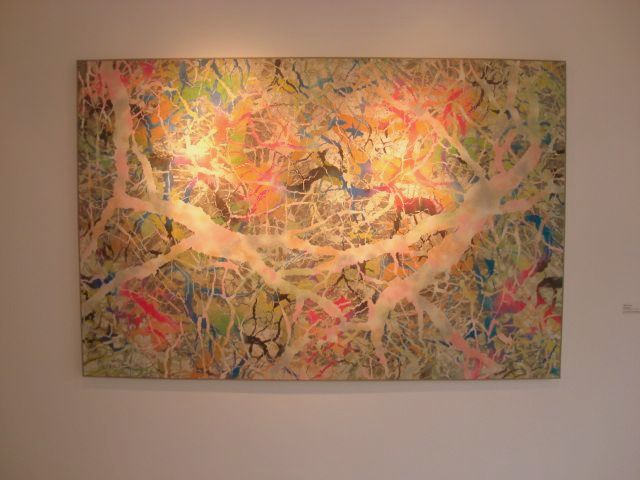
March 1, 2014, by Tony Hong
Global Art in China
By Felicity Woolf,
Studying an MA in Contemporary Chinese Studies at the University of Nottingham Ningbo China.
On a trip to Shanghai last week we decided to visit the Power Station of Art, a newish space for contemporary art opened in 2012 to house the Shanghai Biennale. It has received a bit of attention from Western media on the Guardian culture website and in an article on museums in The Economist and we were intrigued to see what it was like in the flesh. The view seemed to be that China likes building the ‘hardware’  – there were 2,000 museums in 2000 and nearly 4,000 by 2012 – but is not so good at the ‘software’, that is the content and its management.
– there were 2,000 museums in 2000 and nearly 4,000 by 2012 – but is not so good at the ‘software’, that is the content and its management.
The newness of the Power Station of Art was manifest in the fact that the road given as its address didn’t show on any recent map we possessed. We made our own map from Google, found the nearest subway station and hoped for the best. As its name implies, the PSA is a refurbished industrial building, and its massive factory chimney makes it easy enough to identify once you emerge from underground. It is on the site of Expo 2010, now a windswept and rather bleak area of redevelopment on the west bank of the Huangpu River, south of the central area and the old city.
As you get nearer the building, the familiar signs of contemporary art institutions begin to appear. There is a huge, neon thermometer lit up on the side of the chimney and on the river bank, a set of flying, colourful moulded women’s legs greet you. Two huge inflatable monkeys mark the entrance, one hanging from the roof and one sitting by the door.
Inside all sense of being in a specific country or locality disappears. You are in the world of globalized art. The huge inner hall is reminiscent of Tate’s Turbine Hall, while the inevitable shop is a clone of similar enterprises all over the world, from the mugs with the PSA logo to the art books and the high end artist designed jewellery. The interior has the mandatory escalators and there is no colour except black, white and grey.
At first my heart sank. The building felt cold and empty. How depressing that every country as it becomes rich feels that it must emulate this one style. But we pressed on and looked at the exhibition, which was the response of many designers from all over the world to urbanisation. The playfulness of some of the exhibits won us round – the umbrellas of ‘Auto Gene’ that opened and closed by computer linked to ‘Singing in the Rain’ or the furniture screen made from upcycled and recut DVDs.
A Dutch exhibit was a maze of blue polystyrene bricks and we suddenly came across a group of young Chinese students running in out of it, chasing each other and playing hide and seek. They shouted and whooped; the white cube environment didn’t seem to inhibit them in any way.
The next day we sought out another recent space – Shanghai’s Museum of Contemporary Art – which is in the middle of the traditional Chinese garden section of People’s Square. This is again an adaptation of an existing building, but this time a greenhouse. It was recently built but didn’t attract enough visitors and was put up for sale. MOCA is a privately run, relatively small space and you can almost always see trees, sky and other buildings outside through the glass as you gradually rise up through the exhibition on a gently sloping walkway. This helps you to feel that you are in a specific location, rather than in Global Artland. All the more so for us, as from the terrace outside we could look across to where we’d had lunch in the restaurant on top of the old Shanghai race course building.
The exhibition was a one woman retrospective by a Japanese artist Kusama Yayoi – an obsessive compulsive by her own definition. It was hugely popular (no sign of anti-Japanese nationalism here), and MOCA was swarming with young people – mostly young women – who were entranced by the brightly coloured, shiny plastic or resin sculptures of dogs, pumpkins, and giant flowers. They queued up happily to enter womb-like red tents full of mirrors and balloons covered in white dots. The favourite exhibit was a space where you entered to ‘obliterate’ the room and its contents with coloured sticky spots. Just as at the Power Station of Art, interaction
Outside again, we sat on a bench in the gardens and watched the world go by. A young man was teaching his friend some self-defence moves, elderly people played cards, wrapped in heavy jackets and fur hats, a woman walked by with a radio blaring music – all absolutely normal activities in Chinese parks. Somehow the smaller scale and the context of MOCA, despite the fact that the exhibition was representative of global art, made the experience a lot more memorable.
No comments yet, fill out a comment to be the first

Leave a Reply